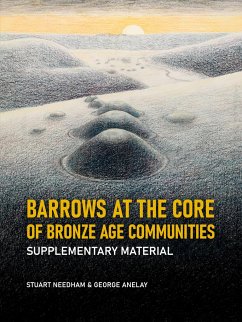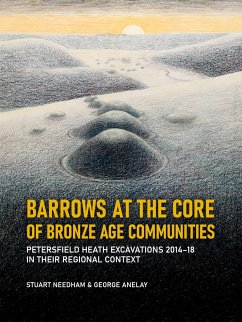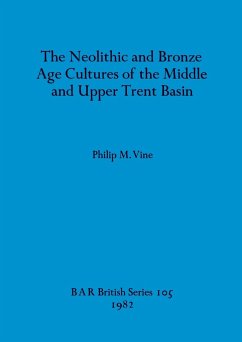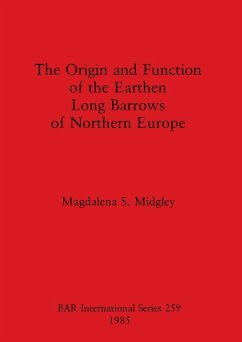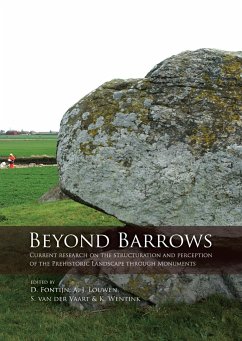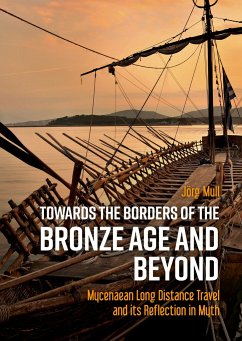
Barrows at the core of Bronze Age Communities
Versandkostenfrei!
Versandfertig in 1-2 Wochen
148,99 €
inkl. MwSt.
Weitere Ausgaben:

PAYBACK Punkte
74 °P sammeln!
Barrows at the Core of Bronze Age Communities argues exactly that. Round barrows do not just represent the death side of Early Bronze Age communities placed in set-a-side ritual landscapes, but were instead central to existence in many ways. This study of the Rother Region, where the Weald meets the Wessex massif, reports the results of the People of the Heath project, 2014-18. It integrates a wealth of data from comprehensive field study of all relevant sites in the region with that from excavations into one of its major cemeteries - Petersfield Heath, Hampshire. Fourteen of 21 surviving barr...
Barrows at the Core of Bronze Age Communities argues exactly that. Round barrows do not just represent the death side of Early Bronze Age communities placed in set-a-side ritual landscapes, but were instead central to existence in many ways. This study of the Rother Region, where the Weald meets the Wessex massif, reports the results of the People of the Heath project, 2014-18. It integrates a wealth of data from comprehensive field study of all relevant sites in the region with that from excavations into one of its major cemeteries - Petersfield Heath, Hampshire. Fourteen of 21 surviving barrows were sampled by excavation, one of the fullest records for such a cemetery in modern times. In addition to diverse burial rites, the site yielded a range of 'other significant deposits' and totally novel insights into the organic artefact repertoire thanks to mineral replacement.There are substantial repercussions for the conventional classification of barrows and in this region the key difference between mound barrows and enclosure barrows is seen to have a socio-cultural background. This and other differences of approach to the siting and aggregation of barrows contribute to the reconstruction of 16 settled communities across the region. These emerge from a strong Mesolithic to Neolithic presence, the latter documented for the first time, and evidence including solstitial alignments suggests direct continuity to the Middle Bronze Age fieldscapes of the region.This book is supported by a separate volume containing an extensive body of supplementary information and evaluation. Together they contain much new for those researching the period, early burial practices and the prehistoric occupation of the western Weald. They will also galvanise debates about variations in the character of barrowscapes across Britain and the place of the Wessex barrow foci.In addition to this main volume, there is also a second volume with: Supplementary MaterialIn addition to the two printed volumes, an online dataset comprising spreadsheets is available at www.peopleoftheheath.com/publications/ContentsForword (by Richard Bradley)AcknowledgementsSection 1: The History and Archaeology of Petersfield HeathChapter 1: People of the Heath ProjectChapter 2: The Archaeology of Petersfield Heath: the State of KnowledgeChapter 3: The Heath in Documented HistorySection 2: Petersfield Heath ExcavationsChapter 4: In Situ Mesolithic SitesChapter 5: Early Bronze Age Enclosure BarrowsChapter 6: Early Bronze Age Mound BarrowsChapter 7: Modern and Natural SitesSection 3: Burials and Other Significant DepositsChapter 8: Burials in Graves and CoffinsChapter 9: Urn Burials (by Jane King and Stuart Needham)Chapter 10: Other Significant DepositsSection 4: Excavated Finds, Environmental Evidence and DatingChapter 11: Bone StudiesChapter 12: Prehistoric Flintwork and a Review of the Regional MesolithicChapter 13: Artefact StudiesChapter 14: Environmental StudiesChapter 15: SpecialistDating Evidence and Site Phasing (by Stuart Needham, Peter Marshall and George Anelay)Section 5: Barrows in the Rother RegionChapter 16: The Regional Barrow SurveyChapter 17: Barrows in the Landscape: Density, Topographic Settings, Formations and Alignments (by Stuart Needham and Sabine Stevenson)Chapter 18: Patterns of Destruction and Survival in the Barrowscape (by Stuart Needham and Sabine Stevenson)Section 6: SynthesisChapter 19: Bronze Age Funerary Deposits and Structures in the Rother RegionChapter 20: Neolithic and Bronze Age Occupation of the Rother Region (by Stuart Needham and Sabine Stevenson)Chapter 21: Identifying Early Bronze Age CommunitiesChapter 22: Petersfield Heath, Enclosure Barrows and Cultural DifferentiationReferences



